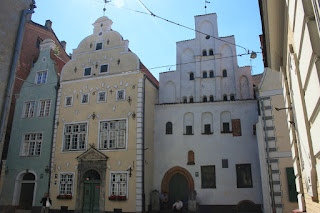


negotiated the bumpy road & traffic into town, and chanced upon a very
handy car park very close to the information centre where we didn't
find alot of helpful information - so set about seeing the sites with
our very large Europe lonely planet book that only had a couple of
pages dedicated to Riga's sites.
Like Tallin, Riga's development since being 'born' in 1201 has had a
large influence from the German based Hanseatic League, then over
later years Polish, Lithuanian, Swedish and Russian rule. Latvia's
run of independence between the 2 world wars and then Russian and
German occupation follows pretty much the same story as Estonia's.
Getting lost in Riga's medieval streets we explored; The largest
church in the Baltics - the Dome Cathedral. The 14th century Powder
Tower apparently has 9 Russian cannonballs still embedded in its walls
- we saw 2, although I find it hard to believe that they weren't put
there just for us tourists. The Swedish gate - built in 1698 while
the Swedish occupied Riga. The large Freedom Monument, built in 1935
to celebrate Latvia's independence. While under Soviet rule until
1991, leaving flowers at this monument base was punishable by
deportation to Siberia. Walking around the very pleasant gardens
circling the old town we found the memorial stones commemorating the 5
government officials who were killed on 20 January 1991 by the Soviets
during Latvia's ultimate move towards independence. Some of the
buildings around looked as though they had been there for centuries,
but they are actually replicas built in the last 10 years after being
ruined in World War 2, then flattened by the Soviets.
A highlight was the visit to the Museum of the Occupation of Latvia.
While shown from the Latvian point of view, meaning there could be
some bias - the museum showed the struggle that the Latvian people
endured from 1940 to 1991.
Stories included how the world saw footage of apparently thousands of
Latvians attending pro-Soviet rallies, where infact the majority of
supporters were Russian navy personal who'd sailed into Riga the night
before.
During the war between Russia and Germany, Latvian men were
conscripted to both sides - meaning inevitably brother was shooting at
brother, or father at son.
Any crime, real or imagined, was punishable by imprisonment in soviet
gulag prison/forced labour camps. There, due to unhygenic conditions,
the harsh winters and lack of adequate food and clothing, few
survived. Of the Latvians sent to Siberia only about 1% returned.
Finaally the eventual decline of the Soviet Union the finally brought
Latvia's independence on 21 August 1991.


No comments:
Post a Comment